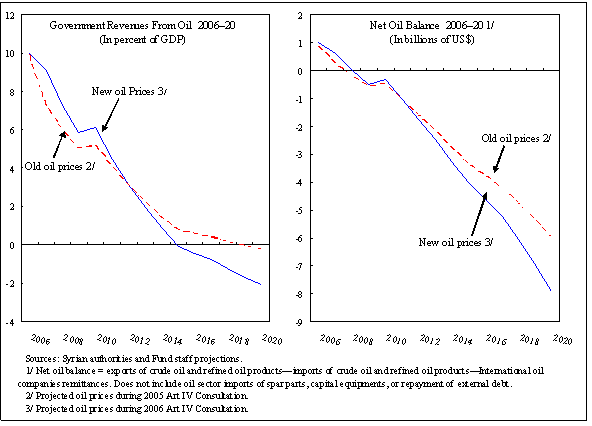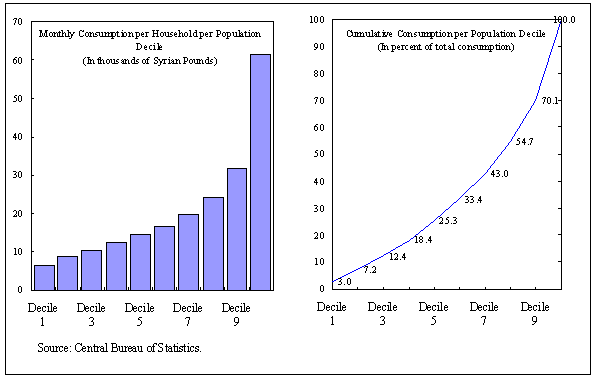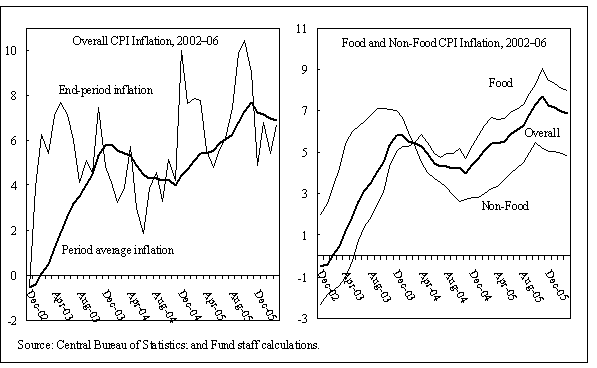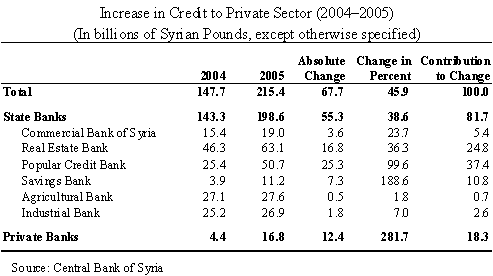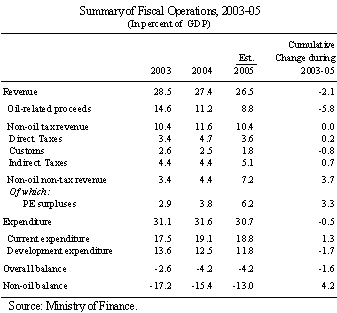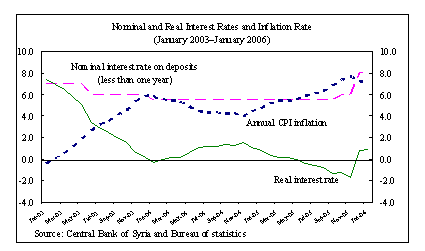Syrian Arab Republic -- IMF Article IV Consultation, Mission's Concluding Statement
May 14, 2006
Describes the preliminary findings of IMF staff at the conclusion of certain missions (official staff visits, in most cases to member countries). Missions are undertaken as part of regular (usually annual) consultations under Article IV of the IMF's Articles of Agreement, in the context of a request to use IMF resources (borrow from the IMF), as part of discussions of staff monitored programs, and as part of other staff reviews of economic developments.
1. The Syrian economy is facing daunting challenges. The dwindling of its oil reserves will create a serious challenge to fiscal and external sustainability. The loss of oil income will make it harder to preserve, let alone, expand living standards. A budge in entrants to the labor market will add strain on an already precarious unemployment situation and increase the political pressure to protect redundant labor in an overstaffed public sector. These challenges are further compounded by growing political uncertainties, which cloud the country's overall business climate.
2. To address these challenges, a number of reforms have already been initiated to encourage private entrepreneurship, promote market mechanisms, open the economy to the rest of the world, liberalize the financial system, and begin to strengthen the medium-term fiscal outlook. An increasing number of sectors have been opened to private enterprise (including most recently the insurance sector) and exposed to international competition (including most recently textile and cement), while the foreign exchange regime has been gradually liberalized. And although Syria still ranks poorly in the World Bank's indicator Doing Business (121st out of 155 countries) there has been a momentum for reform to improve the overall business climate, including through a noteworthy simplification of the tax system and substantial improvement in the regulatory framework for the tourism sector. Outdated business laws and commercial codes are being revised, and the legal and regulatory framework to launch a securities market is being laid out. Overall, government interference is declining and private entrepreneurship is on the rise. Furthermore, the sharp deterioration in the non-oil budget balance during 1999-2003 has been fully reversed during the past two years (see below) auguring well for the commitment of the authorities to strengthen the medium-term fiscal outlook.
3. The reform momentum has contributed to an improvement in economic performance, reflecting strong confidence despite the unsettling political developments. Real non-oil growth has picked up in 2004-05, driven notably by higher private investment and exports, building on a strong economic activity in the region as well as an increased demand for investment opportunities.
|
4. The recent surge in international oil prices has provided a short-term windfall, but will aggravate the fiscal and external outlook in the medium- to longer run when Syria becomes a net oil importer around the year 2010. Higher oil prices will impose an increasingly heavier burden on the balance of payments and higher costs on producers and on consumers—if they are passed through—or, otherwise, on public finances. Based on the latest authorities' medium-term baseline projections for the level of oil output, staff estimates that the net foreign exchange receipts from oil will swing from a surplus of about US$0.7 billion in 2005 to a deficit of about US$4 billion in 2015. Commensurately oil revenues to the budget will decline from 8.8 percent of GDP in 2005 to about nil in 2015.
5. Against this background, government policies should remain focused on the two inter-related challenges posed by the prospective decline in oil revenues, namely:
Given the high synergies between these two pillars of a comprehensive reform strategy, the challenge is to strike the right balance between working on promoting growth and counting on it to solve some of the fiscal problem, and proceeding with fiscal consolidation while minimizing any of its potential adverse effect on growth. Lack of fiscal adjustment to underpin financial stability will undermine growth, and fiscal adjustment without growth would mean a painful contraction of the economy as the oil sector shrinks. 6. The reform strategy laid in the recently approved 5-year plan is broadly in line with this vision. Recognizing the above challenges, the 5-year plan identifies financial sector development, business environment enhancement, and trade liberalization as the core areas of structural reforms to accelerate growth (to 7 percent by 2010), lower unemployment (to 8 percent by 2010), and reduce poverty. It also calls for far-reaching reforms in tax policy and tax administration, public finance management, civil service, price subsidies, and public enterprises. These fiscal reforms aim not only to protect fiscal solvency but also to improve the efficiency and effectiveness of public expenditure and to further enhance the business climate by reducing compliance costs on taxpayers and ensuring a fair distribution of the tax burden. The plan also calls for a unification of the exchange rate and a strengthening of the monetary policy framework as means to strengthen market mechanisms in the pricing of financial assets to underpin the development of the financial sector and ensure the most efficient allocation of private sector savings. 7. We regard the weak domestic capacity and the quasi-absence of social safety nets as the main obstacles to achieving the ambitious goals of the 5-year plan and to accelerating the transition to a market economy:
I. Recent Macroeconomic Developments8. The economy proved quite resilient in the face of the uncertainties that have dominated the political landscape throughout most of 2005. Preliminary data suggest a strengthening of domestic demand together with a robust performance of exports may have boosted non-oil GDP growth to about 5½ percent, from 5 percent in 2004.1 Excess liquidity in the Gulf countries together with some brightening of investment prospects may have supported high growth of private investment. Private consumption was boosted by the fast-paced expansion of domestic credit, the increase in capital inflows from neighboring countries which fed a boom in real estate, and the carry forward effect of the 20 percent public sector wage increase in mid-2004. Significant tariff reductions and some liberalization of foreign exchange gave an additional incentive for increased imports and consumption. Nonetheless, net-exports contributed positively to growth and resulted in an improvement in the external non-oil current account deficit, which preserve external balance despite the halving of the net oil balance. 9. Economic growth was however accompanied by a significant rise in inflation, with annual CPI inflation running at 7 percent at end-December 2005, compared with 4½ percent in 2004. The rise in inflation reflected in addition to the buoyant domestic demand, the impact of the depreciation of the exchange rate—triggered by a confidence crisis fueled by heightened political uncertainty toward the end of the year—and limited competition in products markets. These effects have offset the positive impact from the lowering of tariffs.
10. Monetary policy during 2005 was expansionary. Credit to the private sector grew by 45 percent, of which 70 percent was contributed by three state banks, which raised significantly their ceilings on single borrower loans and introduced new products such as overdrafts. The strong bias in this credit expansion toward consumer loans at a time when enterprises and in particular SME continue to be credit constrained has added to the inflationary impact of this credit expansion. Furthermore, the fast-paced credit expansion is likely to have weakened the quality of banks' loan portfolios—given weak risk management practices—and made banks run into liquidity problems.
11. Following a remarkable improvement in 2004, the non-oil budget balance improved further in 2005. Preliminary data suggests that the non-oil budget balance narrowed by about 2½ percent of GDP in 2005 on top of the 1¾ percentage points of GDP improvement in 2004. The strengthening of the underlying fiscal position has been, however, mainly driven by a surge in the surplus of public enterprises. Total spending declined only marginally—with a drop in development expenditure offsetting an increase in current expenditure driven by large wage increases. Non-oil tax revenues remained flat at about 10½ percent of GDP compared to their level in 2003, with additional revenues from broadening the base of indirect taxes offsetting a drop in international trade taxes—due notably to significant tariff reduction—and income and profit taxes holding up at about 3½ percent of GDP, despite significant reduction in tax rates.
12. The surge in the surplus of public enterprises being the main source of the improvement in the underlying fiscal position casts great uncertainty as to the sustainability of the fiscal improvement and represents, for the moment, a major source of fiscal risk. While some of the improvement could be attributed to higher dividend from the telecommunication company due to a boom in the use of mobile phones, the sustainability of the large increase in transfers from state banks is more uncertain. Poor accounting standards and the opaque way in which public enterprise accounts are consolidated within the general government budget hamper a full analysis of the reasons behind the ostensible improvement in the financial position of the other public enterprises. This also raises the question of how this can be consistent with what is known about their endemic problems. 13. The improvement in the non-oil budget balance in 2005 was fully offset by a commensurate decline in oil revenues, leaving the overall budget deficit unchanged at about 4¼ percent of GDP. Due to net repayments of external debt, bank financing of the budget deficit contributed half of the overall expansion of broad liquidity—competing with the private sector for scarce non-inflationary domestic financing. II. Ensuring Macroeconomic Stability in the Short Term14. The outlook for 2006 is fairly positive, but inflationary pressures need to be addressed. Domestic as well as foreign demand are expected to drive non-oil GDP growth slightly above 5½ percent supported by robust investment expansion and export performance, reflecting, among others, greater access to regional Arab markets under the Greater Arab Free Trade Agreement, and the benefits from the concerted policy to promote Syrian tourism.2 On the policy side, reining in credit expansion and wage increases should stem inflationary pressures and, combined with the recent strengthening of the exchange rate, could bring down inflation to about 5 percent. 15. The above outlook is therefore predicated on prudent monetary and restrained wage policies, and sustained policies to improve the business climate. Continued strong credit expansion and further public sector wage increase during the year would have knock-on effects on private sector wages and household demand, fueling inflation, and undermining competitiveness. A slowdown in the pace of economic reforms could possibly dissuade investors who have recently shown increasing confidence in the country's potential. Furthermore, the uncertainty surrounding the regional environment represents an additional source of downside risk. 16. The 2006 budget together with measures adopted subsequently is expected to yield close to ½ percentage-point improvement in the underlying fiscal position.3 This would reflect a 1 percentage-point of GDP yield from the increase in the price of cement and gasoline, of which half was eroded by the wage increase granted in early February. Together with the modest increase in oil revenues due to the hike in international oil prices, this fiscal tightening should narrow the overall budget deficit to 3¼ percent of GDP and limit the inflationary and crowding out impact of its domestic financing. 17. The improvement in the 2006 budget should not be eroded by further wage increases. A 20 percent across-the-board increase in public sector wages will increase the government wage bill by SP20 billion per year, creating an additional permanent entitlement equivalent to 1¼ percent of GDP. Further wage increases will not only make fiscal sustainability harder to achieve, but will undermine the already weak financial position of PEs and put pressure on private enterprises' wages damaging their ability to create jobs and to compete in a more open economy. Any further expansion in the wage bill should be used to finance the cost of a civil service reform aimed at achieving a professional, merit based and career oriented civil service, with wages linked to performance and wage levels linked to appropriate private sector comparators and enhanced incentives for senior staff performance. 18. Monetary policy should be tightened. Overall credit ceilings should be lowered. The 2 percentage-points hike in interest rates in November, which had restored positive real interest rates, should be maintained until inflation pressures show clear signs of abating. Seen against the 3 percent increase in U.S. dollar interest rates since January 2005, the increase in Syrian Pound interest rates is largely warranted. Greater upward flexibility in lending rates should be introduced to allow greater efficiency in credit allocation and to strengthen banks profitability—as the actual spreads are putting undue pressures on profit margins. Greater flexibility in deposit rates for private banks should also be allowed.
III. Preparing for the future19. The positive outlook for 2006 should not allow for any complacency, as the medium-term challenges need to be addressed without delay. To ensure fiscal and external sustainability in the future, and boost non-oil growth on a lasting basis, there is, now, a need to translate the broad strategy laid down in the 5-year plan into a time-bound matrix of concrete policy actions. In the mission's view, the following key issues would need to be addressed: Consolidating public finances 20. To address the decline in oil revenues and maintain fiscal sustainability, we would advise to anchor Syria's fiscal policy framework to a steady improvement in the non-oil budget balance. The 5-year plan aims to contain the budget deficit measured by the overall balance below 5 percent of GDP and to limit the rise of public debt to no more than 45 percent of GDP by 2010. Given its projections of the decline in oil revenues, the plan is consistent with a 5-6 percentage points of GDP fiscal adjustment during 2006-2010. While the new forward looking orientation in fiscal policy is welcome, setting the main objective of fiscal policy in terms of the overall budget balance does not guard against the risk that no adjustment takes place should oil revenues turn to be higher than anticipated. A more suitable anchor would be a steady improvement in the non-oil budget balance. Assessing the magnitude of the needed improvement in the non-oil budget balance has to be made with an eye on: (i) the public debt dynamic; and (ii) the cyclical position of the economy. While it is true that the stock of public debt is moderate and some additional indebtedness permissible to cushion the impact of the fiscal shock on the economy, we would advise a more limited and gradual increase in public debt. A 7 percentage-points of GDP increase in public debt over 5 years—as envisaged in the 5-year plan—would not be prudent. 21. The five-year plan identifies the introduction of the VAT and the reform of the PPS as the main pillars of the required fiscal adjustment. The mission welcomes the thrust of this view:
22. Regarding the design of the VAT, the mission strongly recommends that the VAT be imposed on virtually all goods and services. Rather than limiting its coverage to few sectors in order to shield the poor from price increases, adopting quasi-universal coverage and providing targeted assistance to the poor is a much better strategy. Roughly speaking, for every SP 100 raised from the VAT, only SP 12 will be contributed by the 30 percent of the poorer segment of society. Raising SP 100 and returning to the poor SP 12 will yield a net revenue to the government of SP 88 without hurting the poor. Introducing the VAT on a limited number of goods, with a view to progressively expanding the coverage, carries two risks/problems. First, experience in the rest of the world indicates that it is very difficult to bring into the tax net sectors which were initially exempted. It took Pakistan over 4 years to finally succeed in expanding the coverage of the VAT to retail trade. Second, exempting sectors causes tax cascading, which can be particularly damaging for exports. An appropriately high threshold, which should be adopted for cost effectiveness—will in any case exclude from the tax net the small retailers from whom the poor would usually buy their food. 23. Reform in tax policy should be accompanied by improvements in tax administration to make the tax system easier to comply with. Work is in train to launch a large taxpayer unit, develop a unique taxpayer identification system, and introduce self-assessment. However, some delays have been experienced, particular in the preparation for introducing self-assessment. This agenda needs to be brought back on track as soon as possible by issuing the needed amendments to the tax procedure code (processes for tax audit based on risk analysis and selection criteria, penalty regime, and simple dispute resolution system). Unifying the exchange rate and achieving current account convertibility 24. The recent trend improvement in the BOP outlook supported by good export performance and buoyant foreign direct investment offers a favorable environment for moving swiftly to unify the exchange rate and adopt current account convertibility. Of all regulations and restrictions that have stifled investment, production, and trade, those associated with the arcane foreign exchange regime are probably those that have had the most damaging impact on the business environment in Syria. Having outlived any usefulness they may have had in the past, they have simply made Syria lose to outside financial centers a large share of the lucrative business of foreign exchange dealings. 25. Exchange rate unification implies that the exchange rate at which the public sector conducts its foreign exchange operations is no longer set administratively by the budget law. All demand and supply of foreign exchange emanating from current account transactions of both the public and the private sector have to meet in a single market, where the central bank will be a major player acting to prevent excessive volatility and to ensure a competitive rate. Letting a change in the market-determined exchange rate force a change in budgetary spending is part and parcel of the automatic stabilizers that allow fiscal policy to work as an instrument for short-term macroeconomic stabilization. If there are demand pressures that put downward pressures on the exchange rate, reducing public spending within the approved budget ceilings will contribute to moderating the demand pressures and stabilizing the exchange rate. 26. Exchange rate unification requires that the central bank acts quickly to complete the preparation for launching a wholesale interbank foreign exchange market. Following the adoption of the law on foreign exchange bureaus and on the foreign exchange open position of banks, the central bank needs to complete, the remaining preparatory work for the logistics of the market and work hard to build the needed capacity for an effective presence in the interbank foreign exchange market. If the transfer of the bulk of official reserves from the Commercial Bank of Syria (CboS) to the central bank can not be completed before the start of the interbank foreign exchange rate market, a special provision for the CboS's open foreign exchange position has to be adopted in such a way that the CboS's weight in the foreign exchange market does not allow it to work across purposes vis-à-vis the central bank's exchange rate policy. 27. Continuing to manage the exchange rate tightly will serve Syria well in the near term. Greater exchange rate volatility will be costly mainly because: (i) it will raise the cost of external trade and dampen trade flows, given the lack of hedging instruments, and (ii) it will weaken the role the exchange rate has played in the past in anchoring inflation expectation. This been said, greater flexibility will be needed in the future to facilitate adjustment of the real exchange rate, which may well be required, given the prospective depletion of oil reserves and further trade liberalization. 28. Managing the float could aim to prevent excessive volatility in the effective nominal exchange vis-à-vis the currencies of major trading partners rather than the nominal bilateral rate vis-à-vis the US$. This policy will protect the competitiveness of the export sector and dampen pass-through of exchange rate volatility into inflation. These benefits, —which are likely to be significant given possibly higher volatility in exchange rates among the major hard currencies in the future,— should be weighed against the weakening of the role of the exchange rate in anchoring inflation expectation. Strengthening the monetary policy framework and the financial sector 29. Notwithstanding the progress in activating monetary policy in the past two years, Syria's monetary policy framework remains rudimentary and in need of major strengthening to allow the central bank to use indirect instruments of monetary control to operate effectively in a financial system that will increasingly become market-based. Indirect instruments will strengthen the price mechanism in the financial sector, ensuring a more efficient allocation of financial resources and a proper pricing of financial risks. 30. Progress toward this medium-term goal should start by having the central bank gain full control of existing direct instruments. The central bank should have the right to decide on credit ceilings and credit policies of banks with a view to ensuring a pace of credit and monetary expansion consistent with maintaining price stability while fostering economic activity and employment. Banks have to abide by all prudential regulations. Beyond this, the role and responsibilities of the central bank and the ministry of finance in exercising oversight on the banks should be clearly defined. While the government could play a lead role in choosing the board and the management of public banks, the CBS should have the authority to evaluate and approve banks' policies, and procedures related to the credit and investment. 31. Furthermore, the CBS should have operational independence and the institutional capacity to exercise effective banking supervision. Indeed, in the absence of effective banking supervision, the strong credit growth and the rapid opening of the banking system could endanger the soundness of the financial sector. Therefore, the mission urges the authorities to:
32. Regarding state bank restructuring, priority should be given to carry out detailed independent audits and diagnostic assessments consistent with accepted international auditing standards. These audits could build on the recent EIB-financed study which highlighted the particularly weak governance in these banks and their low efficiency level, Deciding on the subsequent steps would have to await the conclusion of these audits, which would provide a more reliable assessment of their financial situation and would provide an indispensable basis for examining the merits of various restructuring options. Among these options, the mission invites the authorities to consider the merits of opening the capital of some of these banks to strategic investors to whom full management control should be handed over. Such an option can be an effective way to address the weak governance in some of these banks and inject in them new capital and modern banking expertise. Liquidation is another option for significantly under-capitalized and weak banks. Merging two or more of these banks will be complex, arduous and fraught with risks. Further promoting trade liberalization: 33. Despite notable progress, trade restrictions, particularly nontariff barriers remain substantial and constitute an impediment to growth acceleration. The lowering of tariffs over the last two years is certainly impressive, and the removal of import prohibition for certain goods (textile, cement) will help to reduce the misallocation of resources in the economy. However, some trade barriers, in particular non-tariff, are still significant, sheltering the domestic industry from international competition, increasing the costs of imported goods to the consumers, and discouraging the entry of new traders,. Their non-transparency add to their cost on the economy. 34. The authorities' efforts should be geared in priority toward the removal of nontariff barriers as follows:
35. Furthermore, as regards customs tariff reform, additional steps could be envisaged, such as:
36. The recently concluded bilateral or regional trade agreements should have positive effects but the risks of trade diversion are not negligible and tend to increase with the relative preferences given to a group of countries. Consideration should be given to reducing relative preferences. The priority should be to remove nontariff barriers for all trading partners, as these barriers are high and their elimination bear no fiscal costs. Lowering the level of customs tariff for all trading partners (Most Favored Nation basis) in parallel with the implementation of the preferential agreement with the EU and Turkey would help reduce the preferential gap, facilitate competitive access to efficient imports. Improving the business climate 37. In addition to trade liberalization measures, the authorities' intention to modernize their economic regulations should help send tangible signals to investors and improve the reality and the perception of the business climate in Syria. The draft law on competition, should enhance fair competition between the public and private sectors. The draft company law is a step in the right direction as it simplifies the procedures and lowers the administrative costs of starting a business. On account of these changes, Syria's ranking in the World Bank indicator for the ease of starting a business will improve from 135 to 91. Scrapping the onerous minimum capital requirement, which at 50 times GDP per capital is the highest in the world, will elevate Syria's standing to 32nd place. 38. Tax incentives to promote investments should be narrowed in order to broaden the tax base and allow a gradual lowing of the corporate tax rate. Improving the overall business climate has proven in other countries to have a much more significant impact on boosting investment than providing tax incentives. In this respect, the envisaged single law on investment should aim at treating all businesses equally in order to promote a level playing field. Tax incentives (such as tax holidays and export promotion incentives) that favor one type of activity over another should be eliminated. To encourage investment, the law could provide for a low single corporate income tax rate (say of no more than 25 percent) and a generous system of depreciation allowances, which might include an initial investment allowance or an investment tax credit. Incentives already granted should be grandfathered. 39. We wish the authorities success in pursuing the demanding agenda of reforms ahead and in living up to the commitments they made, and thank them for their generous hospitality, their excellent cooperation and extreme patience, and for the high quality of the discussion. The mission would welcome the authorities' decision to publish this concluding statement, and is pleased to know that the authorities intend to publish the upcoming staff report. 1 Overall growth was limited to 3 percent, given the decline in oil production. 2 This policy is enhancing not only the export potential of this sector but contributing significantly to spreading the benefits from growth to all regions. 3 The non-oil budget balance reflected in Table 8 shows a deterioration of 0.2 percent of GDP. The 0.6 percent of GDP yield of the increase in the price of gasoline, which is a genuine revenues and which is counted in oil-related proceeds, should be added to the non-oil balance for a proper assessment of the extent of the fiscal adjustment. 4 The impact of increasing petroleum prices will fall disproportionately more on the demand for petroleum products, minimizing the demand contraction for other goods and generating a greater oil surplus for export. Phasing out PPS will also reduce pervasive smuggling. 5 The efficiency of government spending should be improved further by phasing out subsidies and price controls on other consumer products. Resulting savings from these measures would create space for increased spending on education, health and infrastructure, as well as financing social safety nets. |
IMF EXTERNAL RELATIONS DEPARTMENT
| Public Affairs | Media Relations | |||
|---|---|---|---|---|
| E-mail: | publicaffairs@imf.org | E-mail: | media@imf.org | |
| Fax: | 202-623-6220 | Phone: | 202-623-7100 | |



